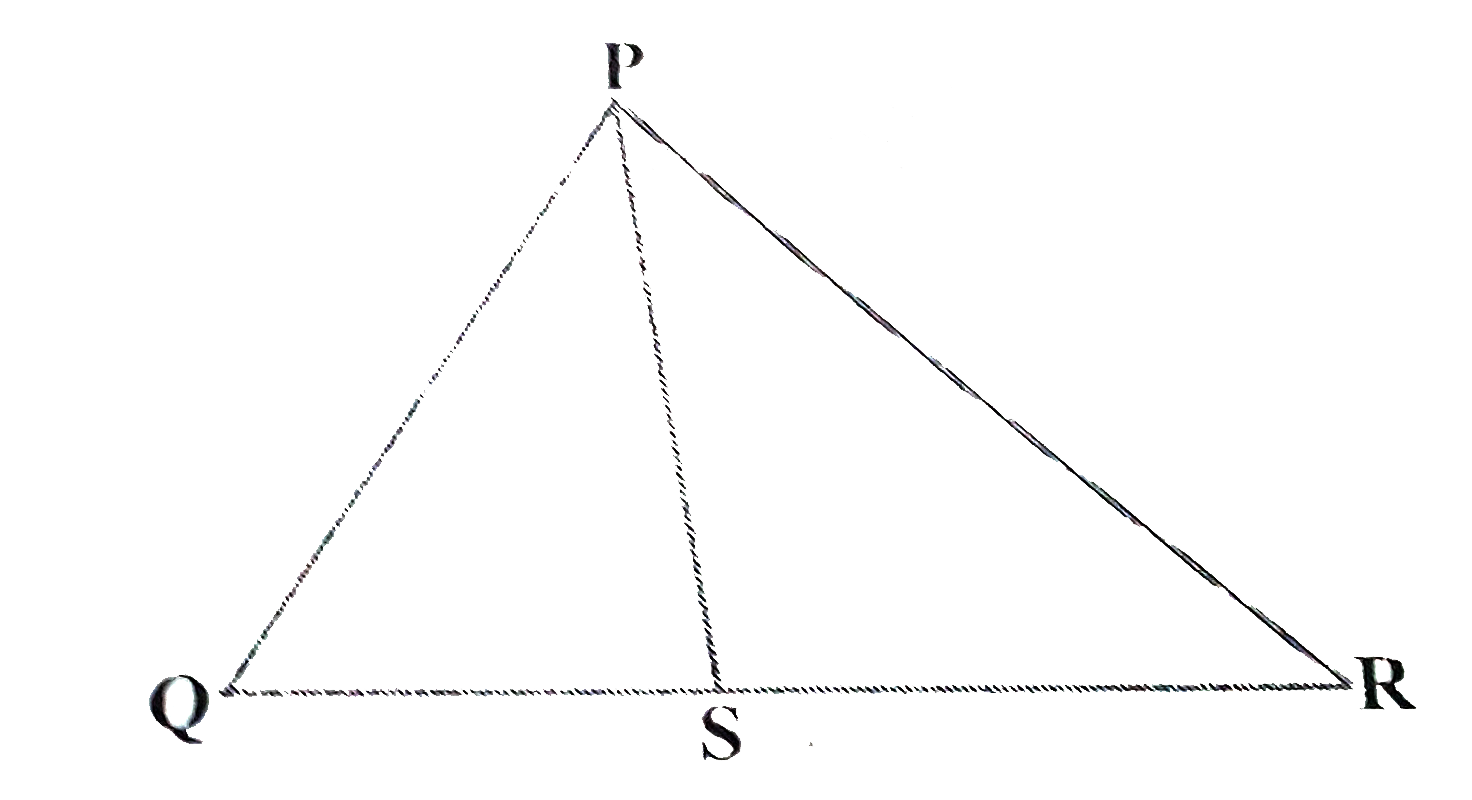In PQR, QM⊥PR and PR2−PQ2=QR2 . Prove that QM2=PM×MR
To solve the problem, we need to prove that QM2=PM×MR given that in triangle PQR, QM⊥PR and PR2−PQ2=QR2.
1. Understanding the Given Information:
- We have triangle PQR with QM perpendicular to PR.
- The equation PR2−PQ2=QR2 suggests that we can apply the Pythagorean theorem.
2. Identifying the Right Angle:
- From the equation PR2−PQ2=QR2, we can rearrange it to PR2=QR2+PQ2.
- This indicates that PR is the hypotenuse of triangle PQR, and thus ∠Q is 90∘.
3. Drawing the Diagram:
- Draw triangle PQR with points P, Q, and R.
- Mark point M on line PR such that QM⊥PR.
4. Labeling Angles:
- Let ∠P=1 and ∠R=2.
- Since ∠Q=90∘, we have 1+2+90∘=180∘.
5. Using Triangle Properties:
- In triangle PQM, we have angles 1, 90∘, and ∠PMQ.
- In triangle QMR, we have angles 2, 90∘, and ∠QMR.
6. Establishing Angle Relationships:
- From the triangles, we can conclude:
- ∠PMQ=2 (since ∠PMQ+1+90∘=180∘)
- ∠QMR=1 (since ∠QMR+2+90∘=180∘)
7. Proving Similarity of Triangles:
- Since ∠PMQ=∠QMR and both triangles share the right angle, triangles PQM and QMR are similar by AA (Angle-Angle) similarity.
8. Setting Up Proportions:
- From the similarity of triangles, we have:
PQQR=QMMR=PMQM
9. Cross-Multiplying:
- From the proportion QMMR=PQQR, we can write:
QM⋅QR=PQ⋅MR
- Rearranging gives:
QM2=PM⋅MR
10. Conclusion:
- We have proved that QM2=PM×MR, which is what we needed to show.
- We have triangle PQR with QM perpendicular to PR.
- The equation PR2−PQ2=QR2 suggests that we can apply the Pythagorean theorem.
- From the equation PR2−PQ2=QR2, we can rearrange it to PR2=QR2+PQ2.
- This indicates that PR is the hypotenuse of triangle PQR, and thus ∠Q is 90∘.
- Draw triangle PQR with points P, Q, and R.
- Mark point M on line PR such that QM⊥PR.
- Let ∠P=1 and ∠R=2.
- Since ∠Q=90∘, we have 1+2+90∘=180∘.
- In triangle PQM, we have angles 1, 90∘, and ∠PMQ.
- In triangle QMR, we have angles 2, 90∘, and ∠QMR.
- From the triangles, we can conclude:
- ∠PMQ=2 (since ∠PMQ+1+90∘=180∘)
- ∠QMR=1 (since ∠QMR+2+90∘=180∘)
- Since ∠PMQ=∠QMR and both triangles share the right angle, triangles PQM and QMR are similar by AA (Angle-Angle) similarity.
- From the similarity of triangles, we have:
PQQR=QMMR=PMQM
- From the proportion QMMR=PQQR, we can write:
QM⋅QR=PQ⋅MR
- Rearranging gives:
QM2=PM⋅MR
- We have proved that QM2=PM×MR, which is what we needed to show.
Topper's Solved these Questions
- BOOK - NAGEEN PRAKASHAN ENGLISHCHAPTER - TRIANGLES EXERCISE - Problems From NCERT/ Exemplar14videos
TRIANGLES
- BOOK - NAGEEN PRAKASHAN ENGLISHCHAPTER - TRIANGLES EXERCISE - Exercise 6a24videos
TRIANGLES
- BOOK - NAGEEN PRAKASHAN ENGLISHCHAPTER - STATISTICS EXERCISE - Revision Exercise Long Answer Questions4videos
STATISTICS
- BOOK - NAGEEN PRAKASHAN ENGLISHCHAPTER - VOLUME AND SURFACE AREA OF SOLIDSEXERCISE - Revisions Exercise Long Answer Questions5videos
VOLUME AND SURFACE AREA OF SOLIDS
Similar Questions
In Figure, it is given that LM=MN, QM=MR, ML ⊥PQ and MN ⊥PR. Prove that PQ=PR
View SolutionIf P + Q = R and P - Q = S, prove that R2+S2=2(P2+Q2)
View SolutionIn Figure, PS=QR and ∠SPQ=∠RQP. Prove that PQS ≅ QPR, PR=QS and ∠QPR= ∠PQS
View SolutionIn Fig 7.51, PR > PQand PS bisects ∠QPR. Prove that ∠PSR >∠PSQ.
 View Solution
View SolutionIn figure PS is the bisector of ∠QPRof ΔPQR. Prove that QSSR=PQPR.
 View Solution
View SolutionIn Figure, PQRS is a quadrilateral and T and U are respectively points on PS and RS such that PQ=RQ, ∠PQT=∠RQU and ∠TQS=∠UQS. Prove that QT=QU.
View SolutionIn triangle PQR, if PQ=RQ and L, M and N are the mid-points of the sides PQ, QR and RP respectively. Prove that LN=MN.
View SolutionPQR is a triangle right-angled at P and M is a point on QR such that PM⊥QR. Show thatPM2=QM.MR.
View SolutionIn △PQR , M and N are points on sides PQ and PR respectively such that PM=15cm and NR=8cm . If PQ=25cm and PR=20cm state whether MN∣∣QR .
View SolutionIn Figure, ∠PQR= ∠PRQ, then prove that ∠PQS= ∠PRT.
View Solution

